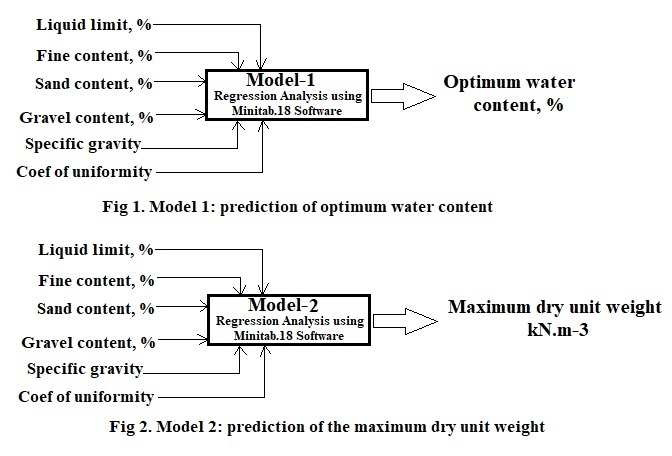Estimation of Optimum Moisture Content and Maximum Dry Unit Weight of Fine-Grained Soils using Numerical Methods
DOI:
https://doi.org/10.48048/wjst.2021.22792Keywords:
Fine-grained soils, Maximum dry unit weight, Optimum water content, Geotechnical properties, Multivariate analysisAbstract
Soil compaction is one of the basic engineering techniques, which is carried out to guarantee the stability of soils dependent on specified strength. Nonetheless, in large-scale construction projects, the estimation of compaction features required tremendous effort and time that can be saved utilizing empirical relationships at the initial phases. It becomes critical to develop models to predict the compaction features, namely the maximum dry unit weight (γdmax) and optimum water content (WOP). This article attempts to develop models to predict the γdmax and WOP of fine-grained clay soils. Geotechnical tests such as grain size distribution, Atterberg limits, specific gravity, and proctor compaction tests are performed to assess soil samples' physical and hyro-mechanical characteristics. Multivariate analysis is conducted using MINITAB 18 software to develop the predictive models. The validation process of developed models includes the determination coefficient, probability value (p-value), comparison of the predicted values with experimental values, comparison of the models proposed in this study with other existing models found in the recent literature, and employing a different soil data set. The predicted values obtained from the models proposed in this research project are more accurate than other models developed recently. The proposed models estimate the compaction features of fine-grained clay soils with acceptable precision.
HIGHLIGHTS
- Soil compaction is one of the basic engineering techniques perform to guarantee the stability of soils dependent on specified strength
- In large-scale construction projects, the estimation of compaction parameters required tremendous effort and time that can be saved utilizing empirical relationships at the initial phases
- This study has developed semi-empirical models to predict the compaction parameters (maximum dry unit weight and optimum water content) of fine-grained soils
GRAPHICAL ABSTRACT
Downloads
Metrics
References
A Sridharan and HB Nagaraj. Plastic limit and compaction characteristics of fine grained soils. Proc. Inst. Civ. Eng. Ground Improv. 2005; 9, 17-22.
R Mohd and G Che. 2005, Correlation regression between soil compaction parameters and atterberg limits. Bachelor Thesis. Universiti Teknologi Malaysia, Johor, Malaysia.
K Faizah. 2005, Estimation of compaction parameters based on atterberg limits. Master Thesis. Universiti Teknologi Malaysia, Johor, Malaysia.
O Sivrikaya, E Togrol and C Kayadelen. Estimating compaction behavior of fine-grained soils based on compaction energy. Can. Geotech. J. 2008; 45, 751-67.
S Noor, R Chitra and M Gupta. Estimation of proctor properties of compacted fine grained soils from index and physical properties. Int. J. Earth Sci. Eng. 2011; 4, 147-50.
A Singh and S Noor. Soil compression index prediction model for fine grained soils. Int. J. Innovat. Eng. Tech. 2012; 14, 34-7.
N Naderi, P Roshani, MZ Samani and MA Tutunchian. Application of genetic programming for estimation of soil compaction parameters. Appl. Mech. Mater. 2012; 147, 70-4.
K Đoković, D Rakić and M Ljubojev. Estimation of soil compaction parameters based on the atterberg limits. Min. Metall. Eng. Bor 2013; 4, 1-16.
A Idris, MI Waziri, AY Abdulfatah and M Umar. Modelling and prediction of compaction parameters based on atterberg limits and clay content. J. Eng. Tech. 2014; 9, 24-7.
NGK Shien, YM Chew, MH Osman and SK Mohamad Ghazali. Estimating maximum dry density and optimum moisture content of compacted soils. In: Proceedings of the International Conference on Advances in Civil and Environmental Engineering, Pulau Pinang, Malaysia, 2015.
KH Jyothirmayi, T Gnanananda and K Suresh. Prediction of compaction characteristics of soil using plastic limit. Int. J. Res. Eng. Tech. 2015; 4, 253-6.
H Arif, MM Hasan, MR Islam and MA Alim. Prediction of compaction parameters of soil using support vector regression. Curr. Trends Civ. Struct. Eng. 2019; 4, 000580.
W Firomsa and ET Quezon. Parametric modelling on the relationships between atterberg limits and compaction characteristics of fine-grained soils. Int. J. Adv. Res. Eng. Appl. Sci. 2019; 8, 1-20.
A Hussain and C Atalar. Estimation of compaction characteristics of soils using atterberg limits. In: Proceedings of the 5th International Conference on New Advances in Civil Engineering, Kyrenia, Cyprus, 2020.
AA Fondjo and E Theron. Application of mathematical function to estimate the compaction characteristics of unsaturated soils. Civ. Eng. Architect. 2021; 9, 255-62.
ASTM. Standard test method for particle-size distriution (gradation) of soils using sieve analysis. American Society for Testing and Materials, PA, USA, 2009.
ASTM. Standard test method for particle-size distribution (gradation) of fine-grained soils using the sedimentation (hydrometer) analysis. American Society for Testing and Materials, PA, USA, 2016.
ASTM. Standard test method for liquid limit, plastic limit, and plasticity index of soils. American Society for Testing and Materials, PA, USA, 2005.
SABS. Civil engineering test methods, determination of the maximum dry density and optimum moisture content. South Africa Bureau of Standards, Pretoria, 2016.
ASTM. Standard test method for the specific gravity of soils. American Society for Testing and Materials, PA, USA, 2014.
RA Johnson. Miller and Freund’s Probability and Statistics for Engineers. 7th ed. Prentice Hall, New Jersey, USA, 2005.
AA Fondjo and TC Dzogbewu. Assessment of stress raiser factor using finite element solvers. Univ. J. Mech. Eng. 2012; 7, 367-79.
Downloads
Published
How to Cite
Issue
Section
License

This work is licensed under a Creative Commons Attribution-NonCommercial-NoDerivatives 4.0 International License.













